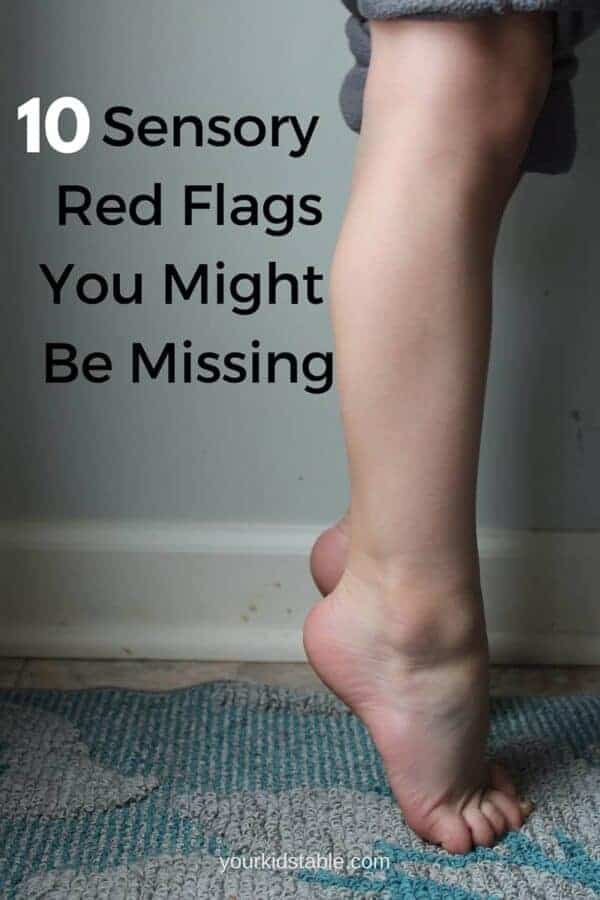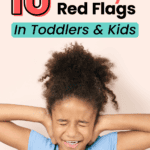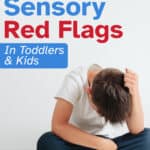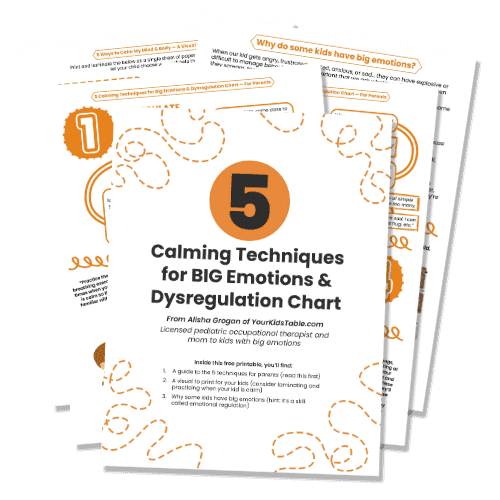Commonly overlooked sensory red flags and signs of sensory issues that could be a clue to your child’s needs, which will decrease confusion and frustration.
This thing happens to me all the time as a pediatric OT… I’m talking to parents during a party, a play-date, or even in line at the grocery store, and the parent casually mentions, often in passing, an odd thing that their child does.
Maybe their child walks around on their toes all the time, gags at some foods, or their toddler hates swings or being messy? Sometimes, they aren’t even that concerned about this odd “thing”.
Often times, I know this “thing” their child is doing is a sensory “issue” or sign of a sensory processing difficulties (which isn’t as bad as it sounds!)
Just because your toddler doesn’t like messy hands doesn’t necessarily mean there is a problem, but it is worth paying attention to.
Sensory processing can be very complicated, and the truth is many parents have never heard about it. Some realize their child may have some sensory issues that sometimes cause odd, confusing, or frustrating behaviors.
When I find myself in these situations, I usually feel a bit stuck because sensory processing isn’t exactly a quick topic, especially for parents who’ve never even heard about it.
If you’ve found your way here, my bet is that you know at least a little something about sensory processing, but if not, that is okay, too.
Either way, I have an exciting solution to that problem, but before I get to that, let’s talk more about these sensory red flags.
What are Sensory Red Flags Exactly?
A sensory red flag is a sign that a child may have a sensory “issue,” or as we prefer to say, a sensory need. Others may call it a sensory behavior. Basically, it’s anything your child does that indicates their sensory system needs more sensory input or less.
That sensory need happens because of the way their unique brain is “thinking” about the sensory input it’s receiving.
It’s not a choice they are making, but literally because of how their brain is wired.
Let me give you a REALLY simple example. My son loves to jump on the furniture. This is a sensory red flag or sign for him because I can see that he is trying to get more sensory input when he’s doing that.
I wanted to write about a few of the most overlooked sensory behaviors or red flags, so that you can begin seeing why your child does seemingly odd or unusual things.
Understanding why your child is waving a sensory red flag, or displaying signs of sensory issues, will help you help them!
But before you even do that, you need to know what the heck this sensory thing is all about. Because I know that as I sit and write this, many of you are feeling overwhelmed or frustrated.
It’s a reaction that I’ve seen too many times to count, and, to be honest, it gets my anxiety going up because I want to help you! I know the solution to that frustration and overwhelming feeling.
Here’s a short video summing up why it’s important to identify sensory red flags, and why they don’t mean something is wrong with your child.
10 Sensory Processing Challenges and Red Flags
Before we dive into these behaviors, I want to make it VERY clear that just because your child may have one or several of these red flags, it doesn’t mean that they have sensory problems, autism, or any other diagnosis.
We ALL have sensory processing needs and differences. Seeing your child’s behavior through the sensory lens will allow you to understand them and support their needs, which means less confusion and frustration for everybody!
And, if you’re concerned that your child’s sensory issues need addressed by a professional, then check out sensory integration therapy.
You’ll find a guide to walk you through figuring that all out so you have peace of mind! If you are concerned your child has autism, or already know they do, check out the link between autism and sensory processing.
1. Avoids Movement – If your child gets scared at climbing playground equipment, roughhousing, or riding a swing, they are likely avoiding vestibular and possibly proprioceptive input.
Those are our sixth and seventh senses that give us our sense of balance and body awareness.
2. Gagging at the Sight, Taste, and Smell of Foods – Although not always sensory, gagging immediately when confronted with foods is often because the oral system is being overwhelmed. Read more about sensory issues with food.
3. Frequently Walking on Toes – Children often do this because they are sensitive to the sensations they are feeling on their feet and prefer as little of their foot to be touching the surface as possible.
Sometime children toe-walk because they like the pressure it puts on their ankle, which is more proprioceptive feedback. Or, it can also be the result of a vestibular system that isn’t processing properly.
4. Clumsy – There are a variety of reasons that a child may seem to fall or bump into objects more than other children, and one of the most overlooked reasons is because the child’s proprioception and possibly vestibular systems aren’t working too well.
The wiring may be all jumbled up.
Some children with this sensory red flag don’t put their hands out when falling, or seems unaware of how to catch themself when off balance.
5. Hides at Parties or Avoids Them – If your child hates going to parties or other public places, it is possible that they may be overstimulated by the noise, lights, and/or people accidentally touching them.
For kids that have this response due to a sensory processing difficulty, a party can be downright torture as the sounds, sights, and unexpected touches can just be painful to them, literally. Head to sensory sensitivity in kids to learn more.
6. Prefers Tight Clothing – Sometimes kids will want to layer clothes or wear really tight fitting clothing to give themselves more proprioceptive input. It may seem strange, but the sensation they receive is calming to them and may even help them focus better.
Or, your child may be extremely particular about some sort of fabric. This all relates back to sensory. Head over to sensory issues with clothing to learn more.
7. Wild Child– There are a variety of reasons that kids seem to bounce off the walls at times, but kids that always seem to be jumping, climbing, running, pushing, and roughhousing are typically seeking out proprioceptive input, and sometimes vestibular as well.
Unfortunately, these kids are often described as “bad” or wild, but really, they are just trying to get their needs met. Read more about sensory strategies for sensory seekers or “wild kids”, and a three part plan for “dealing with” hyperactive kids.
8. Likes Bright, Fast Paced TV Shows – I know a lot of kids like these types of shows, but if your child only wants to watch fast, bright shows, then it may be an indication that they want more visual stimulation.
If that is the case, your child may also like looking at lights and brightly colored or high contrast books.
9. Bites Toys or People When Unprovoked – If your child seems to bite others or their toys often, usually for no reason, they are probably looking for some deep, intense proprioceptive input or oral sensory input.
10. Doesn’t seem to notice when being talked to or needs directions repeated – Yes, sometimes kids ignore, and sometimes this is normal, but if it is a frequent recurring issue than it is a sign that your child’s auditory or hearing system is not processing information well.
Check out 11 more sensory red flags in the follow up post.
Does Your Child Have Sensory Red Flags?
All of these behaviors are like a red flag that your child is waving to tell you something about their sensory processing.
It is a clue into what they need from a sensory standpoint. That need may be help avoiding something like bright lights or seeking something like chewing on toys.
To start figuring out what types of sensory activities might be helpful for your child, follow these steps:
1. Identify which type of sensory need your child has. There are four big categories for sensory issues: seeking, avoiding, low registration, and varied. If that feels overwhelming or you have no idea, I highly recommend our free 1 hour workshop that will help you figure it out!
2. Once you know which type of sensory need your child has then you can match the types of sensory diet activities that will be most helpful for them!
3. Organize when and how often you use the sensory activities by using a sensory diet, which has nothing to do with food, but is a diet of supports and sensory input that help calm and organize your child’s brain.
(Steps 2 and 3 are also taught in the free sensory workshop!)
Get the 21 Sensory Red Flags Printable Checklist
Wish you had all these red flags and 11 more you might be missing in a list you could download and/or print out?
I’ve got you covered! Click here to get the 21 Sensory Red Flags checklist sent right to your inbox!
More on Kids Sensory Red Flags
Does Your Child Cry All The Time? This Might Be Why…
33 Signs of Sensory Processing Disorder
How to Identify Sensory Issues in Toddlers
4 Simple After School Routines That Will Cut the Chaos.
Alisha Grogan is a licensed occupational therapist and founder of Your Kid’s Table. She has over 19 years experience with expertise in sensory processing and feeding development in babies, toddlers, and children. Alisha also has 3 boys of her own at home. Learn more about her here.






My great grandson pulls fibers off fuzzy blankets, the Spider-Man design off his bed( sticker) cloth covering off side of leather couch cushions. Takes cup holders off car seat. He has to dismantle everything and then leave laying
Hi Rita,
Sounds like he likes the tactile sensation from these things and also likes to understand how things go together and work! Thanks for sharing,
Best,
Laura
Your Kid’s Table OT
Hello,
My 2 month old infant is not responding well to things like the ceiling fan, baby swings, lights, music. She loves them for about 1 minute and will kick and smile but then it usually ends in her crying or throwing up, even if she ate 2/3 hours ago.
Why is this? Is she too young for this kind of stimulation?
Hi Samantha,
It’s possible the throwing/spitting up is not related to the sensory stimulation, so please make sure you are closely following the guidance of your pediatrician regarding this if it is impacting her growth. However, if you are noticing a consistent reaction to movement, especially head movement and change in direction, it sounds like a vestibular sensitivity which may be worth looking into. At her age, if you are in the state, early intervention is usually covered for free and they could see if they could work toward helping her.
Best,
Laura
Your Kid’s Table team member